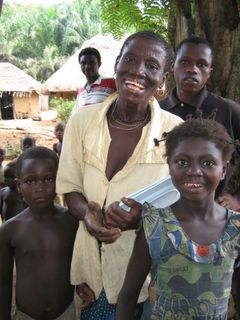Your comments on my recent post “On Being Homeless” made me think long and hard about homelessness. I remember helping a Congolese colleague get a visa for the States to attend a conference. When I asked him what he thought of North America, he professed being shocked at the number of homeless people there. Indeed, the United States is a well-organized country with wealth and social services and the idea of disenfranchised and abandoned people was appalling to him in that setting.
Some thoughts on homelessness...
How many homeless people are there in the United States?From Wikipedia - http://en.wikipedia.org/wiki/Homelessness_in_the_United_States
Total Number As many as 3.5 million people experience homelessness in a given year (1% of the entire U.S. population or 10% of its poor), and about 842,000 people on any given day.
Familial composition40% are families with children—the fastest growing segment.
41% are single males.
14% are single females.
5% are minors unaccompanied by adults.
Why are people homeless in the United States?Well, there are many reasons. Sometimes it boils down to economic factors (people loose their jobs and cannot pay rent), other times it can be mental illness (people prefer living free and unconstrained instead of being forced to take medication).
How did homelessness become such a big issue here?There are several events that precipitated homelessness to what it is today in the United States.
In the 1960, President Reagan signs the
Mental Retardation Facilities and Community Mental Health Centers Construction Act. The main idea behind this act is to take fragmented arrangement of separate, independent, and often noncommunicating, hospitals, clinics and agencies, and organized them into a service network called community mental health centers (CMHCs).
Except, these centers are crushed by the number of newly deinstitutionalized patients (also a Reagan legacy) and people on work-disability: patients that have little or no money to pay for health services. Due to tight budgets, external services are cut, leaving only the more basic services running.
Reagan decides to cut the budget for the Department of Housing and Urban Development by three-quarters, from $32 billion in 1981 to $7.5 billion by 1988. In fact, the department’s role to give subsidized housing (housing of very low cost) for the poor.
Reagan also changes of tax codes. This reduces incentives for private developers to create low-income homes. Under Reagan, the number of people living beneath the federal poverty line rose from 24.5 million in 1978 to 32.5 million in 1988.
Faced with community centers operating basic services and no subsidized or affordable housing, a large number of people found themselves on the street.
What do shelters provide?From Wikipedia - http://en.wikipedia.org/wiki/Homelessness_in_the_United_States
"Homeless shelters are temporary residences for homeless people. Usually located in urban neighborhoods, they are similar to emergency shelters. The primary difference is that homeless shelters are usually open to anyone, without regard to the reason for need. Some shelters limit their clientele by gender or age.
Most homeless shelters expect clients to stay elsewhere during the day, returning only to sleep, or if the shelter also provides meals, to eat; people in emergency shelters are more likely to stay all day, except for work, school, or errands. Some homeless shelters, however, are open 24 hours a day.
There are daytime-only homeless shelters, where the homeless can go when they cannot stay inside at their night-time sleeping shelter during the day. Such an early model of a daytime homeless shelter providing multi-faceted services is Saint Francis House in Boston, Massachusetts.
Homeless shelters are usually operated by a non-profit agency, or associated with a church. Many get at least part of their funding from local government entities. Shelters can sometimes be referred to as 'human warehouses'.
Homeless shelters sometimes also provide other services, such as a soup kitchen, job seeking skills training, job training, job placement, support groups, and/or substance (i.e., drugs and/or alcohol) abuse treatment. If they do not offer any of these services, they can usually refer their clients to agencies that do."
Why are homeless people not all in sheltersWell, often, shelters are full or refuse you based on your profile (perhaps you are a young white male and the shelter only accept mothers and children). Some people say that there is a large violence problem in shelters and they prefer sleeping in a busy street instead of being raped or robbed of their possessions.
When I lived in Japan, I saw large parks completely usurped by tents and man-made shacks where whole communities of homeless people would reside. They would also open the underground metro when the weather go particularly cold so people wouldn't die outside.
Why don't homeless people apply to job and go to interviews, like I do when I need a job?From Wikipedia - http://en.wikipedia.org/wiki/Homelessness_in_the_United_States
"Since most homeless people have no telephone, or fixed phone number or no personal phone number at all, no computer to access E-mail, no permanent address, or any place to get changed and washed, it can be difficult for a homeless person to apply for, find or even maintain a job; and without a job it can be difficult to raise the money or gain the references needed to acquire accommodation if governmental aid is not available or insufficient."
and
"In some homeless shelters and day centers, the homeless have access to a phone for making local calls, take a shower, and use a post office box at the shelter to receive mail, or sometimes can use a computer to access email. In many shelters and centers, they must signup on a first-come/first-serve list for such services, so it is not always possible to use a phone or have a shower in a timely fashion. The washing and laundering of dirty clothes, which frequently consists simply of the clothes on the person's body, presents an almost insurmountable problem, since many shelters do not provide laundry machines or services and using a public laundromat is not possible with only one set of clothes or lack of money to pay for the use of the laundromat."
What is a homeless person's daily routine? How does it feel to be homeless?Well, I'm not quite sure. I think that it's important for homeless people to get about their day and fill it with normal activities like having two or three meals a day, going to the library, interacting with friends, going to see a movies etc...You would be surprised to find out that some homeless people are very well educated and have a family somewhere. This is the case for this homeless person who blogs about his daily life:
The Homeless GuyWhere can I read more on this issue?My sources are the following:
Democracy Now - http://www.democracynow.org/article.pl?sid=04/06/11/1431244
National Council for Community Behavioral Health Care - http://www.nccbh.org/WHO/Def-resources/History.pdf
Wikipedia - http://en.wikipedia.org/wiki/Deinstitutionalisation
Wikipedia - http://en.wikipedia.org/wiki/Homelessness
Wikipedia - http://en.wikipedia.org/wiki/Homeless_shelter
Blog of a Homeless Man - http://thehomelessguy.blogspot.com/



























 www.cat.cc.md.us/courses/bio141/labmanua/lab22/ascaris.html
www.cat.cc.md.us/courses/bio141/labmanua/lab22/ascaris.html
 Weighing "Refugee Bags" before putting them in the plane's cargo
Weighing "Refugee Bags" before putting them in the plane's cargo The view from a hotel in Goma
The view from a hotel in Goma I'm not sure what this fruit is but they call in a Mountain Potato
I'm not sure what this fruit is but they call in a Mountain Potato